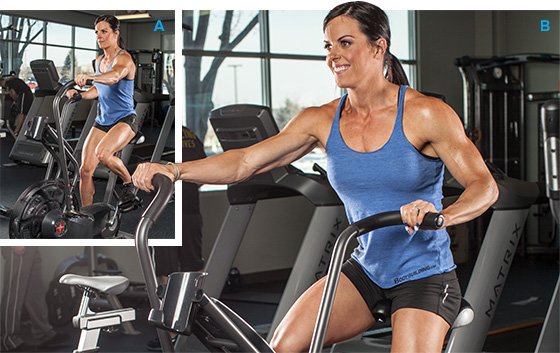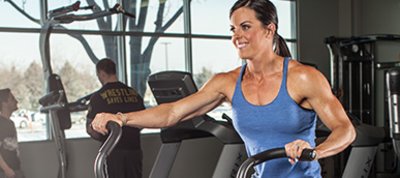When it comes to cardio equipment, four options come to mind: treadmills, Stepmills, bikes, and the elliptical trainer. Unfortunately, this overlooks another and, in my opinion, superior option: the fan bike.
Maybe it's because it looks too old-fashioned, or because it lacks a built-in media center. But no matter what's been holding you back, it's time you became a fan.
An array of fan bike varieties crowds the market, with Schwinn's Airdyne line standing out as the most popular since its introduction in 1978.
You may have seen one on the popular television show "The Ultimate Fighter," but they're also showing up in an increasing number of CrossFit boxes. They've been standard issue in many pro sports training facilities for decades.
With nicknames such as "Satan's tricycle" and "the misery machine," you would think there would be copious spikes or flames shooting out the pedals, but the fan bike appears harmless. All brands and varieties have the same basic design: an upright bike equipped with dual-action handlebars and a huge fan at the front of the bike. The fan spins as you pedal, and it's linked with your speed.
Simple enough, right? How could something that old-school possibly be as difficult as a stair-stepper, max-incline treadmill, or an elliptical with the resistance set high? The short answer: It's all about that fan, man.
A Bike Unlike Any Other
On traditional stationary bikes and elliptical trainers, you have choices. First, you set the resistance, and then you decide how hard you're going to push it. But on a fan bike, you simply get on and start pedaling, and the bike pushes back.
Due to air resistance and the aerodynamics of the fan, the difficulty changes without the push of a button. When you pedal faster, you experience more resistance; when you pedal slower, there's less.

{{caption}}
Fan Bike
The resistance makes pedaling tough. But guess what? Pedaling is only half of the work you do. The coordinated pushing and pulling action of the arms and the pushing action of the legs, combined with the air resistance from the fan, challenges your heart to pump blood to both upper and lower body regions. Physiologically, this is demanding on your cardiovascular system, especially when you pedal as hard as you can.
Sure, the elliptical machine also has handles connected with the footpads, but you'd be wrong to assume that these two pieces of equipment are in the same league. Likewise, you may be seated when using the fan bike, but don't confuse it with any variety of recumbent bike.
The air resistance from the fan results in a workout intensity with no comparison, which is why the fan bike is almost always available in even the most crowded cardio room. Good luck staying on it long enough to watch your favorite show.
Using a Fan Bike For HIIT
The fan bike is an excellent option for high-intensity interval training (HIIT) workouts. The seamless transition between hard and easy efforts allows you to focus the hard work you're supposed to do, rather than scrambling for buttons to change the resistance.
The only thing you'll be looking for are your lungs! Plus, cranking the upper and lower body simultaneously will burn more calories than you can on a standard spin bike, making Satan's tricycle your go-to machine for serious conditioning work.
You may have been Tabata'd over the head enough in recent years to believe that it is the only option worth your precious minutes, but the truth is that HIIT workouts come in many different shapes and sizes (like a Tabata workout). They all share the potential to benefit both aerobic and anaerobic systems development, while also contributing to a greater after-burn effect, also known as excess post-exercise oxygen consumption (EPOC).
This type of hard work is fantastic for increasing calorie expenditure. HIIT sessions tend to be shorter than traditional low-intensity aerobic workouts, but they can actually reap similar physiological benefits. Also, if you're crunched for time, these shorter, more intense sessions are great for training in a busy schedule. Just don't expect them to be pleasant—especially on the fan bike.
Fan Bike Beginner's HIIT Program
Week 1
Perform 3 times per week. An intensity level of 1 is super easy, and 10 is a full-out sprint.
- Warm-up 5 minutes at 5-6 intensity
- Interval training 10 min. of 10 sec. hard (8-10 intensity); 50 sec. easy (4 intensity)
- Cool-down 5 minutes of 5 intensity
Week 2
Perform 3 times
- Warm-up 5 minutes at 5-6 intensity
- Interval training 10 min. of 15 sec. hard (8-10 intensity), 45 sec. easy (4 intensity)
- Cool-down 5 minutes at 5 intensity
Week 3
Perform 3 times
- Warm-up 5 minutes at 5-6 intensity
- Interval training 10 min. of 20 sec. hard (8-10 intensity), 40 sec. easy (4 intensity)
- Cool-down 5 minutes at 5 intensity
Week 4
Perform 3 times
- Warm-up 5 minutes at 5-6 intensity
- Interval training 10 rounds (not minutes) of 15 sec. hard (8-10 intensity), 30 sec. easy (4 intensity)
- Cool-down 5 minutes at 5 intensity
Week 5
Perform 3 times
- Warm-up 5 minutes at 5-6 intensity
- Interval training 10 rounds (not minutes) of 20 sec. hard (8-10 intensity), 20 sec. easy (4 intensity)
- Cool-down 5 minutes at 5 intensity
Week 6
Perform 3 times
- Warm-up 5 minutes at 5-6 intensity
- Interval training 10 rounds (not minutes) of 20 sec. hard (8-10 intensity), 10 sec. easy (4 intensity)
- Cool-down 5 minutes at 5 intensity
Climb the Ladder
Once you find your stride and power through the beginner's plan, you can begin to customize your workouts to prioritize specific goals like fat-loss, strength-endurance, or maximum power. Or you can continue blasting through training that hits all three, like ladder workouts.
Similar to the HIIT of the beginner's program, ladder interval workouts alternate periods of intensity with easy peddling. The difference is that each interval is a different length. The hard intervals gradually increase, while the easy-effort intervals decrease. Here's a sample fan bike ladder workout:
Ladder Intervals
- Warm-up 5 minutes at 5-6 intensity
- Pyramid Intervals Alternate sprints of 8-10 intensity with rest periods of 4 intensity 10 sec sprint, 50 sec rest 20 sec sprint, 40 sec rest 30 sec sprint, 30 sec rest 40 sec sprint, 20 sec rest 50 sec sprint, 10 sec rest 40 sec sprint, 20 sec rest 30 sec sprint, 30 sec rest 20 sec sprint, 40 sec rest 10 sec sprint, 50 sec rest
- Cool-down 5 minutes at 5 intensity
The Time Trial Method
Now things are getting fun. Picture yourself trying to qualify for the Tour de France. Choose your distance (say 1, 2 or 3 miles) and see how fast it takes to complete that distance. It is simple, yet challenging.
Time Trials
- Warm-up 5 minutes at 5-6 intensity
- Time Trial Pick your distance, and get there as fast as you can. Try to beat your time in the future.
- Cool-down 5 minutes at 5 intensity
The Heart Rate Method
Your heart rate responds to the intensity of exercise, so training at different percentages of your maximum heart rate (MHR) will yield different physiological adaptations. This style of training is known as "energy system development." To get a rough estimate of your MHR, subtract your age from 220.
Here are three heart rate zones you can work in to target different energy systems:
60-70% MHR: This zone improves your aerobic capacity and is most commonly used for a warm-up or an easy 30-60-minute cardio session. At this intensity, you should be able to carry on a conversation.
70-80% MHR: Work in this range is often referred to as "lactate threshold training" because it pushes your body's ability to manage increasing concentrations of lactate and other metabolic byproducts. The goal is to develop higher power output over a longer duration.
80-90% MHR: This cardio zone focuses on improving your VO2-max, which is essentially how much oxygen your body can utilize for a given cardiovascular activity. It's affected by your body weight, age, and sex and is the most difficult cardio zone to exercise in because the work intensity is so high.
Heart Rate Training
- Warm-up 5 minutes at 60% MHR
- Heart Rate Workout Choose from zone 2 or 3. Alternate 4-minute intervals in that zone with 2 minutes of easy pedaling. Perform 4 intervals.
- Cool-down 5 minutes at 60% MHR

